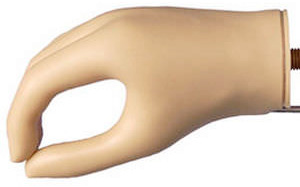Body-powered Arm Prosthesis

Functional prostheses are either body powered or electric-powered. Body-powered devices are operated using cable and harness systems that require the patient to use body movements (moving the shoulders or the arm, for example) to pull the cable and make the terminal device (a hand, hook or prehensor) open or close much in the way a bicycle handbrake system works.
Mechanical body-powered terminal devices are voluntary-opening or voluntary-closing. Voluntary-opening means that users must open the terminal device by applying force through their cable system. The terminal device then closes on its own with the aid of rubber bands, which limit the grip strength of the device to the strength of the rubber bands. With a voluntary closing terminal device, force must be applied to close it instead of to open it, making the grip strength dependent not on the strength of rubber bands but on the strength of the person using it.
Voluntary-opening devices that are closed with the aid of rubber bands offer only visual feedback to the user for control since the bands do the work of closing once an object is grasped, thus taking the body out of the feedback loop. Because they close by the user’s own strength, voluntary-closing devices provide a tension feedback to the body similar to that “felt” when using bicycle handbrakes. Since users can “feel” the force they are applying, they can also control their grip incrementally, applying more or less force as needed.
Cable controlled hand systems are designed to meet the functional needs of the user. They offer straightforward functionality thanks to easy-to-learn movement patterns along with a natural appearance with a wide variety of high definition prosthesis gloves available.
In South Africa this is the most commonly used hand control system as its offer user a cost effective, durable solution.
 Body-powered Prosthesis Parts:
Body-powered Prosthesis Parts:
- Shoulder Anchor
- Cable & Cable Sheath
- Socket
- Elbow Unit (Prostheses Dependent)
- Wrist Unit
- Terminal Device
- Prosthetic Glove (Prostheses Dependent)
Terminal Devices
 Single-Cable System Hand
Single-Cable System Hand
Though artificial hands are generally less functional than hooks and prehensors, some people choose them because of one major advantage: They look more like the human hand.
The hand is actively opened by pulling the cable and closes independently with concurrent locking. The hand and wrist that joins to the forearm is carefully laminated into the prostheses by the prosthetist.
 Hooks
Hooks
Hooks are opened via a harness worn on the upper body. They are closed automatically by spring or rubber elements. Hooks are made of materials that are highly robust (e.g. stainless steel), easy to clean and as lightweight as possible (e.g. aluminium alloys). Hooks are especially well suited for tasks that require the highest gripping precision, for example when handling small items such as screws or nails. A hook also serves as a reliable and very durable gripper for hard manual labour and activities in challenging environments (e.g. solvents, moisture).
In addition to hooks for children and adolescents, both standard hooks for adults and all purpose hooks (e.g. all-purpose claw, all purpose hook, all-purpose ring) are available.
Typical Advantages of Split Hooks:
- Functionality
- Efficiency of use
- Ability to grasp small objects
- Durability
- Lower maintenance and repair costs
- Lighter
- Better ability of user to see what he or she is trying to hold (The size and thickness of artificial hands sometimes block the user’s view of what he or she is trying to pick up. Because artificial hooks and hands can’t feel, being able to see what one is doing is especially important. This also makes hooks – which often have a nitrile coating to prevent slippage– generally better for picking up smaller objects.
- Because hooks are usually made of metal, amputees don’t have to be as careful around heat, which can melt artificial hands.
 Cosmetic Prosthetic Gloves
Cosmetic Prosthetic Gloves
Prosthetic gloves can be used in conjunction with certain types of terminal devices and be costume made or ordered to match your skin tone and complicity.
Gloves for a prosthesis fulfill two important functions:
- For many users, they are a crucial element and the first thing others notice when they see the prosthesis. Their natural appearance makes an important contribution towards the harmonious integration of the prosthesis into the overall body image.
- The glove also protects the mechanics of the prosthetic hand against moisture, dirt and dust.
Prosthetic gloves are made of PVC or Silicon and are highly robust and resistant to tearing. Thanks to a large selection of colors, they can be chosen to meet each individual requirements and their natural appearance is convincing.






